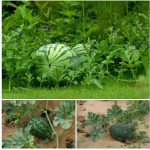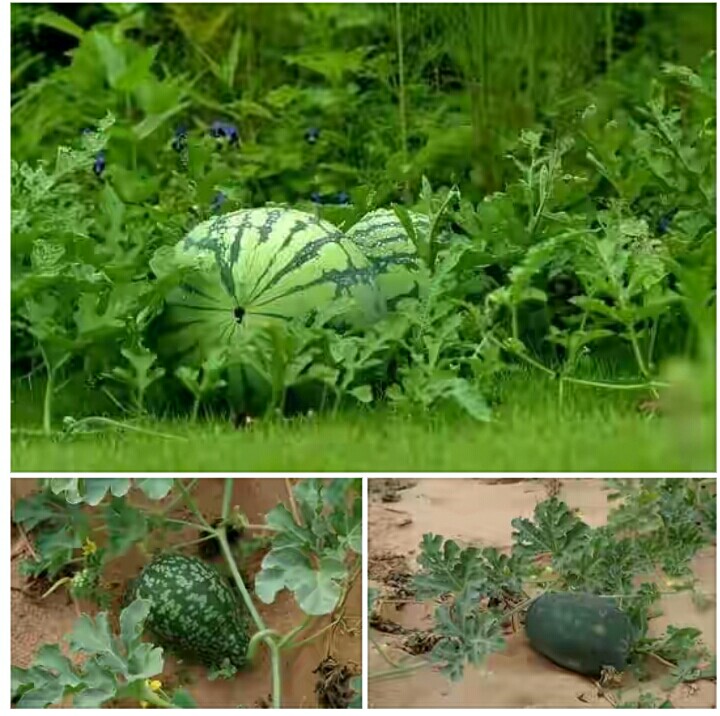Citrullus lanatus; synonyms: Citrullus vulgaris, Momordica lanata (Botanical name) or Watermelon, Dessert water melon, West African watermelon, Egusi melon, Egusi watermelon, Cooking melon, Fodder melon, Preserving melon, Citron (English) or Kankana, Guna, Gunar shanu (Hausa) or Arbuz (Polish) or Egusi agbe (Yoruba) or Cikilje pahe (Fula-Fulfulde): A plant with many underutilized parts
DESCRIPTION ORIGIN AND OCCURRENCE:
Citrullus lanatus is a prostrate or climbing annual plant with several herbaceous, firm and stout stems up to 3 m long. The young parts are densely woolly with yellowish to brownish hairs while the older parts are hairless. The leaves are herbaceous but rigid, becoming rough on both sides; 60-200 mm long and 40-150 mm broad, but usually deeply 3-lobed with the segments again lobed or doubly lobed; the central lobe is much the largest. The leaf stalks are somewhat hairy and up to 150 mm long. The tendrils are rather robust and usually divided in the upper part.
Male and female flowers occur on the same plant (monoecious) with the flower stalk up to 40 mm long and hairy. The fruit in the wild form is subglobose, indehiscent and up to 200 mm in diameter; the fruit stalk is up to 50 mm long. The fruit is usually globose to oblong or ellipsoid, sometimes ovoid, 5-70 cm long and weighing 0.1-3.0 kg (0.1-2.5 kg in egusi melon, 1.5-3.0 kg in watermelon), The seeds are obovate to elliptical, flattened, 0.5-1.5 cm × 0.5-1 cm, smooth, yellow to brown or black, rarely white.
Citrullus lanatus originates from the western Kalahari region of Namibia and Botswana, where it can still be found in the wild in a diversity of forms together with other Citrullus species. In this region there are two major types, one with small fruits that are generally bitter and mainly used for their seeds, called ‘tsama melon’.
This is the probable ancestor of egusi melon. The other type has fruits that are mainly used as a source of water during periods of drought or as cooking melons, and may well represent the ancestral form of the watermelon, fodder melon and cooking melon. Following first domestication of Citrullus lanatus in southern Africa in prehistoric times, its cultivation became widespread in Mediterranean Africa, the Middle East and West Asia more than 3000 years ago. Introduction into India must also have occurred in ancient times and here a strong secondary centre of genetic diversity developed. Citrullus lanatus reached China around the 10th century and Japan in the 16th century. It was introduced to the Americas in early post-Columbian times.
Egusi melon, grown for its seed, has probably been domesticated in the southern Sahel zone or in regions surrounding the Kalahari desert. It is especially important in West Africa.
People in Namibia and Botswana still harvest most of their seeds from the wild, but some landraces have been selected specifically for their oil-rich seed. Cultivars grown in western Sudan are probably of the same type as the egusi melon of West Africa. Seed melons are also important in China. Watermelon is now widespread in all tropical, subtropical and warm temperate (hot summers) regions of the world, including Africa. Cooking melons are mainly found in the northern and eastern parts of the Kalahari Desert. Fodder melon is mainly grown in the United States and South Africa. The composition of dried egusi seed without shell per 100 g is: water 5.1 g, energy 2340 kJ (557 kcal), protein 28.3 g, fat 47.4 g, carbohydrate 15.3 g, Ca 54 mg, P 755 mg, Fe 7.3 mg, thiamin 0.19 mg, riboflavin 0.15 mg, niacin 3.55 mg, folate 58 μg. The seed is an excellent source of energy and contains no hydrocyanic acid, making it suitable as livestock feed. The seed oil consists of glycosides of linoleic, oleic, palmitic and stearic acids.
The fruit flesh contains bitter cucurbitacins. The composition of watermelon per 100 g edible portion (50-70% of the mature fruit) is: water 91.5 g, energy 134 kJ (32 kcal), protein 0.6 g, fat 0.4 g, carbohydrate 7.2 g, Ca 8 mg, P 9 mg, Fe 0.17 mg, thiamine 0.08 mg, riboflavin 0.02 mg, niacin 0.2 mg, folate 2 mg, ascorbic acid 9.6 mg. Watermelon is a rich natural source of lycopene, a carotenoid of great interest because of its antioxidant capacity and potential health benefits.
USES OF WATER MELON
Citrullus lanatus comprises overlapping groups of cultivars that yield seed or edible fruits. Fruits of wild or semi-wild plants are used in the Kalahari region as a source of drinking water. The same use is reported from Sudan. Other primitive forms are used as forage.
Most important in Africa are cultivars of which the only edible portion are the seeds. The fruit pulp of these cultivars is too bitter for human consumption. In West Africa, they are called ‘egusi’, derived from the Yoruba language; in Wolof language (Senegal), they are called ‘beref’. In the Kalahari region, the seeds are considered a delicacy. After roasting, they are ground into a coarse, whitish meal, which is nutritious and pleasantly nutty-tasting. In West Africa, the seeds are made into pulp and added as thickener to soups.
They are also fermented to produce a sweetener locally called ‘ogiri’ or they are roasted, pounded, wrapped in leaves and then boiled to produce another sweetener called ‘igbãlo’. The pulp of roasted and salted seeds is eaten in Sudan and Egypt, where it is called ‘tasali’. In the far northern parts of Sudan, seeds of some types are eaten whole, including the seed-coat, after being roasted; these are called ‘gorom’.
A highly prized vegetable oil is extracted from the seed. This oil is used for cooking and for cosmetic purposes and is of interest to the pharmaceutical industry. The residue from oil extraction is made into balls that are fried to produce a local snack called ‘robo’ in Nigeria, or is used as cattle feed. The oil is used in making soups and in Namibia it has traditionally been used for making soap.
The seeds can be roasted to make a substitute for coffee. Many cultivars are grown as a vegetable crop for fresh consumption of the refreshingly juicy and sweet flesh of the mature fruit. In most parts of the world the watermelon is the most important type of Citrullus lanatus. In several African countries, local non-sweet, non-bitter cultivars are used as cooking melon, e.g. in Kenya, Namibia, Botswana and Zimbabwe. Related types in Sudan are sometimes referred to as ‘citron’ or ‘citronnel’.
Young fruits from which the seeds have been removed are cooked until they are soft. In Zimbabwe, the cooked melons are mixed with cooked beans or cowpeas, and powdered seeds of bottle gourd are added. To preserve the fruit flesh, the seeds and rind are removed and slices are dried in the sun. A stiff porridge is made from mature fruits mixed with maize or pearl millet flour.
The leaves are occasionally used as a cooked vegetable. In the United States the rind of some cultivars is made into pickle or a sweet preserve. In the south of France, the preserving melon or citron is popular for jams. In the extensive farming systems of semi-arid regions, leaves and fruits of fodder melons are a source of forage and water for livestock. The fruits are used as a drastic purgative in Senegal; they are diuretic and used to treat diarrhoea and gonorrhoea in Nigeria. Tar is extracted from the seeds and used for the treatment of scabies and for skin tanning.
ETHNOMEDICINAL SIGNIFICANCE
The root is purgative and in high dose it can also serve as emetic. The seed is demulcent, pectoral and tonic. It is sometimes used in the treatment of the urinary tract infections as well as bed wetting. The fruit is also diuretic and is effective in the treatment of dropsy and renal stones The seed is also a good vermifuge and has a hypotensive action. Preliminary research indicates that the consumption of watermelon may have antihypertensive effects. Fatty oil in the seed, as well as aqueous or alcoholic extracts, had been reported to paralyze tapeworms and roundworms. The rind of the fruit is prescribed in cases of alcoholic poisoning and diabetes.
Citrullus lanatus is used in Northern Sudan for burns, swellings, rheumatism, gout and as laxative. The fruits are used as a drastic purgative in Senegal; they are also used to treat diarrhoea and gonorrhoea in Nigeria. Tar is extracted from the seeds and used for the treatment of scabies and for skin tanning. The seed oil has an anthelmintic action which is better than that of pumpkin seed oil.

FOR FURTHER READING SEE:
1) Kihara, H., 1951. Triploid watermelon. Proceedings of the American Society for Horticultural Science 58: 217-230.
2) Maynard, D.N. (Editor), 2001. Watermelons: characteristics, production and marketing. American Society for Horticultural Science (ASHS) Press. Horticulture Crop Production Series. Alexandria, VA, United States. 227 pp.
3) Robinson, R.W. & Decker-Walters, D.S., 1997. Cucurbits. CAB International, Wallingford, United Kingdom. 226 pp.
These are the thoughts and intellectual property of:
Sa’eed Halilu Bawa
Senior Lecturer (Associate Professor) at University of the West Indies, St. Augustine Campus, Trinidad.
Studied Food and Nutrition Sciences, Dietetics at Kaduna Polytechnic, Nigeria; Warsaw University of Life Sciences, Poland.
























